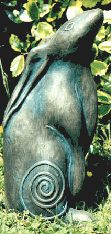Thursday, April 28, 2011
Sunday, April 24, 2011
The Easter Hare

According to Bede the name of the Christian festival of Easter was adopted from an Anglo-Saxon goddess called Eostre, spelt by other writers Eastre, Ostara, or Eastur. The name is cognate with Aurora, Eros and with Ushas, the Sanskrit for dawn. The month of April was called Eostur-monath, the Dawn month, and the pre-Christian festival of Easter included rites symbolic of death and resurrection. Few details are known, but there is no reason to think that it differed basically from other spring festivals such as that of Adonis . . . which were held in Western Asia and in Greek lands.
Eastre's favourite animal and attendant spirit was the hare. Little else is known about her, but it has been suggested that her lights, as goddess of the dawn, were carried by hares. . . . The hare was a companion of Aphrodite too, and of satyrs and cupids. Wedding rings in ancient Greece bore its image and in the Middle Ages it appears beside the figure of Luxuria [self-indulgent sexual desire, personified as one of the deadly sins]. Elsewhere it represented love, fertility and growth. It is associated with the moon, dawn and Easter not only in this respect – as a symbol of physical growth – but in their deeper, spiritual meanings: the enlightenment of the soul through death, redemption and resurrection. Like the Easter egg itself the hare is an emblem of body and soul.
– George Ewart Evans and David Thomson
The Leaping Hare
pp 132-134
The Leaping Hare
pp 132-134
Image: The Leveret.
Saturday, April 23, 2011
Body and Soul

 Like a hare springing erect and bounding exuberantly across a dew-kissed field, the beauty and energy of the aroused male embodies the burgeoning life force often associated with spring.
Like a hare springing erect and bounding exuberantly across a dew-kissed field, the beauty and energy of the aroused male embodies the burgeoning life force often associated with spring. The hare is symbolic of natural phenomena that connote actions of the aroused male: the rising sun, the coming spring. In folklore, art and dreams, hares herald great bursts of energy and creativity. They are often thought to be touched by divine madness, by a spirit of anarchy that overturns dogmatic tradition and restrictions. They are tricksters, offering us new ways of seeing and being in the world. They are emblems of the integration of body and soul.
 The hare was the Anglo-Saxon fertility goddess Eastre's companion and messenger. It is said that her illuminating and warming powers, as goddess of the dawn, were embodied and channeled by hares. Like her, they represent the love and carnal pleasure that can lead to flourishment, to renewal, to the blossoming forth of life. They therefore have a reputation for lusty sexuality and fecundity. One artist who has incorporated this symbolism into his work is Mexican painter and sculptor Francisco Toledo.
The hare was the Anglo-Saxon fertility goddess Eastre's companion and messenger. It is said that her illuminating and warming powers, as goddess of the dawn, were embodied and channeled by hares. Like her, they represent the love and carnal pleasure that can lead to flourishment, to renewal, to the blossoming forth of life. They therefore have a reputation for lusty sexuality and fecundity. One artist who has incorporated this symbolism into his work is Mexican painter and sculptor Francisco Toledo.  Simon Carnell notes that in Toledo's art, "conspicuously sexualized as well as trickster-like hares can be found copulating with, fellating and buggering human figures, in a literalization of their symbolic associations with sex." In Toledo's "Crafty Hare" (opening image) a man-hare possesses four erect penises, two as ears, and is surrounded by wasps with over-sized stingers (pricks!)
Simon Carnell notes that in Toledo's art, "conspicuously sexualized as well as trickster-like hares can be found copulating with, fellating and buggering human figures, in a literalization of their symbolic associations with sex." In Toledo's "Crafty Hare" (opening image) a man-hare possesses four erect penises, two as ears, and is surrounded by wasps with over-sized stingers (pricks!) Image 1: Francisco Toledo.
Image 2: The Leveret.
Image 3: Robert Canis.
Image 4: Francisco Toledo.
Friday, April 22, 2011
Unhoused

[Hares'] speed, camouflage, lack of family life and even size are linked as adaptations to their principal behavioural difference from the rabbit, namely, the fact that they do not burrow. Though there are exceptions to this rule, with certain desert-dwelling hares using or extending the burrows of other animals to escape the sun, and with mountain hares occasionally using short burrows to escape predation from above, most hares make do instead with a 'form' or resting place which consists of only a narrow scrape on the surface of the earth. As a result of this, or an intimate parallel connection to being 'unhoused' or unprotected, hares are extremely precocial.* For whereas rabbits, like most small mammals, are born blind and naked in a prepared 'nest,' leverets are born fully furred, able to see, and able to move about soon after birth. . . . Whereas the rabbit is a large small animal, the hare has developed in ways more consistent with being a small large one.
– Simon Carnell
Hare
p. 61
Hare
p. 61
* precocial – adjective. An animal species active and able to move freely from birth or hatching and requiring little parental care ( opposed to altricial).
Thursday, April 14, 2011
Saturday, April 2, 2011
Subscribe to:
Posts (Atom)





















